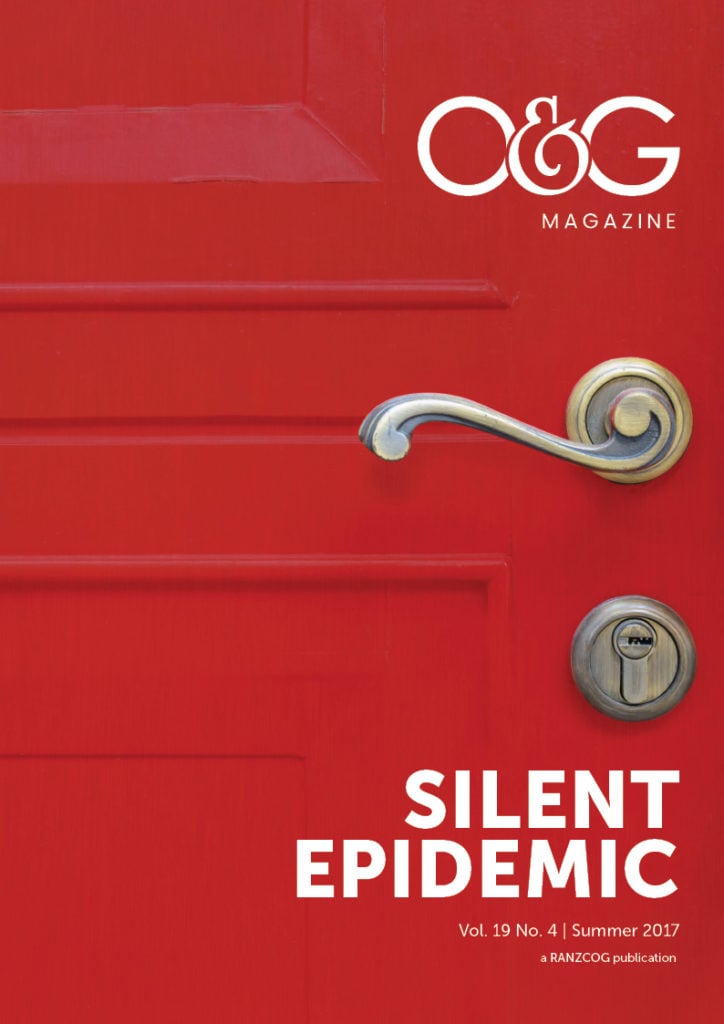While giving a talk recently on contraception, I asked what people thought the most reliable contraceptive is. ‘Abstinence’ said a senior O&G consultant. My response to this seemed to stun; ‘well, as one-in-three women are raped in their life, abstinence is not really an effective solution.’
But is this misogyny? Yes – both the rape and the subtle judgement that if girls didn’t have sex they wouldn’t get pregnant. Misogyny is the dislike of, contempt for, or ingrained prejudice against women. This is an example of ingrained prejudice by the consultant, and it is more common in O&G than we would like to think. Often the perpetrator would be appalled to be called a misogynist. It is worth noting though, that women can be misogynistic much in the way men can be feminists. Other O&G examples include the proposed farcical Victorian and Tasmanian 2016 ASM debate on whether the Mirena should be compulsory for O&G trainees,1 at least I assume they weren’t proposing them for men in some way, so I assume misogyny was at work there too.
Rape of women is obviously misogynous. Global estimates published by WHO indicate that about one-in-three (35 per cent) women worldwide have experienced either physical and/or sexual intimate partner violence or non-partner sexual violence in their lifetime.2 We all accept that rape is ‘bad’; however, it is pervasive in society. If you watch The Hunting Ground, a documentary about the incidence of sexual assault on college campuses in the US,3 the complexity of the support systems become clear; who is more important to the university? The star football player or the raped woman? But I imagine you think ‘that is just the US’. Don’t be so sure. The University of Otago, to date, has no sexual assault policy.
The National Report on Sexual Assault and Sexual Harassment at Australian Universities reported that 51 per cent of students experienced sexual harassment, with women almost twice as likely as men to have been sexually harassed.4 Of those surveyed, 10 per cent of women experienced sexual assault over a two-year period. The report identified that ‘attitudes towards women contribute to sexual assault and sexual harassment at university’.5 This institutional misogyny sets women on their way into the workforce with the implicit understanding that consent is a perception viewed from the eyes of the establishment or ‘boss’. Just how much sexual harassment should you experience before you risk your career by reporting it? Often it is easier to play along and, ultimately, if you are not careful, become complicit in the misogynistic environment yourself.
After the Royal College of Surgeons was exposed by a whistleblower1 there was a rash of interest in the extent of bullying and sexual harassment in medicine in Australia and New Zealand. In 2016, RANZCOG reported 12 per cent of respondents to a harassment and bullying survey had experienced sexual harassment, the majority of those (76.8 per cent) from a senior O&G consultant.6 But I imagine a few people thinking ‘is that really a problem?’ Yes, it is. Just over 100 people respondents confirmed that they had been sexually harassed by their boss. How many had actually reported this bullying and sexual harassment? Only 24 per cent.7
David Grimes is an American O&G who travels the world talking about misogyny, which he identifies as including disdain, apathy, neglect, abuse, rape and femicide. He spoke in 2009 at the RANZCOG ASM on the topic and inspired me, and on his return in 2017 he described mourning the death of his country with the loss of reproductive rights as a result of the election. We should never assume that the rights civil society has fought so hard to achieve cannot be lost.
‘Highly restrictive abortion laws are not associated with lower abortion rates. When countries are grouped according to the grounds under which the procedure is legal, the rate is 37 abortions per 1000 women of childbearing age where it is prohibited altogether or allowed only to save a woman’s life, compared with 34 per 1000 where it is available on request, a non-significant difference’.8 Why is this misogyny? The issue is that the rate of unsafe abortion increases where abortion access is illegal and with that the rate of complications and death. Complications from unsafe abortion are responsible for the deaths of 47,000 women each year.9 Clearly this is not respecting the life of women.
We like to think New Zealand is progressive, the first country to get the vote for women; but in fact, women there still don’t have fundamental human rights. Family size is based on the Contraception, Sterilisation, and Abortion Act 1977,10 contraception is not fully funded and abortion is, at best, a challenge of jumping through ever-moving hoops and, at worst, outright illegal. Most women who have an abortion are determined to be ‘mentally ill’. Caesarean rates in Australia and New Zealand sit at 25–35 per cent,11 12 but despite the fact that abortion is safer than term birth, New Zealand women can’t choose not to carry a pregnancy to term. That is, I would argue, contempt for the value of women’s lives. Why do we trust a woman and her doctor to make decisions together on all other aspects of reproductive health, but not abortion?
Maternal and perinatal mortality statistics in Australia and New Zealand show higher rates in ethnic minorities.13 No doubt this is due to a number of complex issues, but I challenge that misogyny may well be playing a part and when attempting to optimise care for all, we should consider how this factors into the mix.
I have limited this article to the topic of misogyny in reproductive health. There is a whole world outside of these issues where misogyny flourishes. Hopefully, we can at least reduce it in women’s reproductive healthcare. So, what do I want you to take from this piece? Firstly, think: am I a misogynist? Do I support other’s misogynistic behaviour? Add then: can I fight misogyny, or can I change someone else’s misogynistic behaviour?
If you are a Fellow, member or trainee of the College and want to make a complaint about bullying, discrimination or harassment at work, please contact Paula Fernandez, Senior Coordinator, Trainee Liaison on 61 3 9412 2918 or via email [email protected].
References
- McVeigh, S. ‘Awareness’ won’t stop harassment of female surgeons, says whistleblower. ABC (AU). 2016 [cited 2017 Oct 4]. Available from: www.abc.net.au/triplej/programs/hack/public-awareness-wont-stop-sexual-harassment-of-surgeons/7380536.
- World Health Organization. Violence against women – Intimate partner and sexual violence against women. 2016. [Cited 2017 Oct 7] Available from: www.who.int/mediacentre/factsheets/fs239/en.
- Scully RK, Blavin P, Dick K, et al. The Hunting Ground. 2015. Bay Entertainment, Inc. Available from: thehuntinggroundfilm.com.
- Australian Human Rights Commission. Change the course: National report on sexual assault and sexual harassment at Australian universities. 2017, Sydney. [cited 2017 Oct 4]. Available from: www.humanrights.gov.au/sites/default/files/document/publication/AHRC_2017_ChangeTheCourse_UniversityReport.pdf.
- Australian Human Rights Commission. Change the course: National report on sexual assault and sexual harassment at Australian universities. 2017, Sydney. [cited 2017 Oct 4]. Available from: www.humanrights.gov.au/sites/default/files/document/publication/AHRC_2017_ChangeTheCourse_UniversityReport.pdf.
- Killen, A. From the CEO. O&G Magazine. 2016;18(3):9-10.
- Killen, A. From the CEO. O&G Magazine. 2016;18(3):9-10.
- Sedgh G, et al. Abortion incidence between 1990 and 2014: global, regional, and subregional levels and trends. Lancet. 2016;388(10041):258-67.
- Contraception, Sterilisation, and Abortion Act 1977. [cited 2017 Oct 4] Available from: www.legislation.govt.nz/act/public/1977/0112/latest/DLM17680.html.
- Ministry of Health. Report on Maternity 2015. 2017. Wellington: Ministry of Health. Available from: www.health.govt.nz/publication/report-maternity-2015.
- Australian Government Department of Health. National Maternity Services Plan: the current environment. [cited 2017 Jul 4] Available from: www.health.gov.au/internet/publications/publishing.nsf/Content/pacd-maternityservicesplan-toc~pacd-maternityservicesplan-chapter2.
- PMMRC. Tenth Annual Report of the Perinatal and Maternal Mortality Review Committee: Reporting mortality 2014. 2016. Wellington: Health Quality & Safety Commission. Available from: www.hqsc.govt.nz/assets/PMMRC/Publications/tenth-annual-report-FINAL-NS-Jun-2016.pdf.
- AIHW: Monk A, Harris K, Donnolley N, et al. Perinatal deaths in Australia, 1993–2012. 2016. Perinatal deaths series no 1. Cat no PER 86. Canberra: AIHW.






Leave a Reply